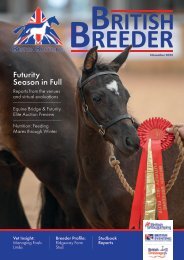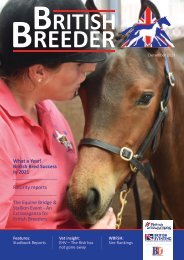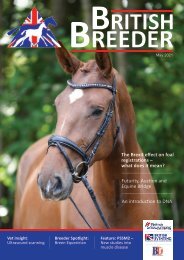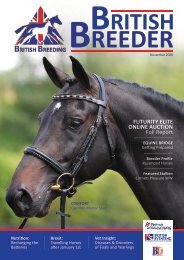British Breeder Magazine May 2020
Magazine for breeders of British bred sport horses. Includes breeding industry news, updates, interviews, profiles and reports.
Magazine for breeders of British bred sport horses. Includes breeding industry news, updates, interviews, profiles and reports.
Create successful ePaper yourself
Turn your PDF publications into a flip-book with our unique Google optimized e-Paper software.
Article - VET INSIGHT<br />
The donor mare is inseminated and just<br />
over a week later her uterus is flushed<br />
with an embryo flushing media. The<br />
fluid is searched for an embryo in a<br />
pre-prepared laboratory. Hygiene<br />
and embryo preservation are the most<br />
important considerations. The embryo is<br />
then frozen or transferred into a suitable,<br />
pre-synchronised recipient mare.<br />
The recipient may be located where<br />
the donor is flushed or the embryo<br />
can be chilled and transported to a<br />
recipient herd elsewhere. It is possible to<br />
synchronise only one recipient per donor<br />
ovulation, but it is strongly advisable<br />
to synchronise 2-3 recipient mares per<br />
possible embryo, as the synchrony<br />
process is not failsafe. Sometimes it is<br />
not possible to synchronise a recipient<br />
for a particular donor cycle due to the<br />
following:<br />
• Timing/asymmetric response to<br />
drugs given.<br />
• Recipient having an undesirable<br />
uterus on the day of transfer,<br />
therefore a second recipient is<br />
needed.<br />
Successful synchronisation requires<br />
skilled veterinary expertise, regular<br />
scanning of both donor and recipients<br />
and a high level of communication<br />
between the vets scanning the donor<br />
& recipients. The synchrony process<br />
should start as soon as the donor is first<br />
scanned - drugs such as prostaglandins/<br />
ovulation induction agents should never<br />
be given to the donor before checking<br />
that the recipient synchrony is on track.<br />
It is a wasted investment producing an<br />
embryo without a suitable recipient’s<br />
uterus to transfer to. The perfect recipient<br />
requires:<br />
• Manageable temperament<br />
• Similar size to donor<br />
• Healthy – including up to date<br />
vaccinations and worming<br />
• Reproductively sound<br />
On going care of the recipient is<br />
essential throughout the pregnancy and<br />
nursing as with any broodmare. Regular<br />
scanning of the pregnancy ensures all is<br />
progressing to plan and no veterinary<br />
intervention is required.<br />
The risks of AI and ET are mainly with<br />
the known risk of a potentially fatal<br />
rectal tear during rectal examination<br />
and scanning. This risk is minimised<br />
by competent reproduction vets and<br />
their use of sedative drugs and rectal<br />
relaxant drugs if necessary as well as<br />
ensuring rectal examinations are carried<br />
out in stocks. Whilst ET is successful in<br />
many candidates, some mares are more<br />
complex and may require a different<br />
approach to secure a pregnancy. Other<br />
methods can include:<br />
Ovum Pick Up (OPU) &<br />
Intra-Cytoplasmic Sperm Injection<br />
(ICSI): In a natural pregnancy the<br />
oocyte (released from the ovary during<br />
ovulation) is fertilised by a sperm in<br />
the oviduct, then the resultant embryo<br />
drops into the uterus. In mares who<br />
suffer with chronic uterus problems or<br />
an oviduct abnormality, OPU/ICSI is<br />
a good option. OPU is done at a clinic<br />
were the mare is sedated and involves<br />
oocytes being retrieved directly from the<br />
ovaries. The oocytes are then sent to an<br />
ICSI lab where they undergo a specialist<br />
IVF procedure involving a single sperm<br />
being injected into the oocyte followed<br />
by a period of embryo development. The<br />
embryo can be frozen for transfer at a<br />
later date, or transferred directly into a<br />
recipient.<br />
The donor is scanned prior to OPU to<br />
ensure she has at least 15 follicles across<br />
both ovaries. The procedure involves a<br />
trans-vaginal scanning method to access<br />
the ovaries and aspirate each viable<br />
follicle to recover an oocyte. The oocyte<br />
recovery rate per follicle is around 50-<br />
60% and usually requires 6-8 oocytes<br />
to successfully produce an embryo using<br />
ICSI. It may not be possible to secure<br />
an an embryo from each OPU session,<br />
it is important to factor in around 2 OPU<br />
sessions (repeatable at 2 week intervals)<br />
for each embryo you want to achieve.<br />
OPU doesn’t require multiple scanning<br />
sessions or AI & Uterine Flushings, but<br />
instead a quick day-case procedure.<br />
Many deceased stallions with limited<br />
stores of frozen semen are now only<br />
available for ICSI produced breedings.<br />
OPU/ICSI can also be performed on<br />
a mare immediately post mortem - if<br />
a valuable mare dies unexpectedly<br />
and the owner wishes to preserve her<br />
bloodlines, then provided the oocytes<br />
are retrieved immediately, it is possible to<br />
produce embryos in the lab.<br />
Cloning is becoming a much more<br />
viable option in terms of success rates,<br />
availability and cost. To clone a horse,<br />
stem cells need to be harvested from the<br />
donor using a simple, minimally invasive<br />
procedure under sedation. These stem<br />
cells are processed in a specialist lab to<br />
produce viable cell lines suitable for use<br />
in the cloning process. These cell lines<br />
can be frozen for use at a later date or<br />
sent immediately to a cloning laboratory<br />
to undergo the cloning process to<br />
produce an embryo. This embryo is then<br />
transferred to a recipient.<br />
Cost is always an important<br />
consideration. It is difficult to accurately<br />
quote since the breeding process for<br />
each horse is different. However it is<br />
useful to assess different sections:<br />
pre-breeding testing, stallion costs,<br />
embryo production, pregnancy<br />
production, pregnancy maintenance,<br />
and foaling. Pre-Breeding testing<br />
costs can vary depending on the stud<br />
requirements and also whether export<br />
testing is needed. As an estimated figure<br />
expect to pay £100 - £300. Stallion<br />
costs and terms vary hugely between<br />
industries, individual stallions and semen<br />
type. Costs need to be established with<br />
the stallion owner/agent. There are also<br />
mare (NC) & semen (AI) transport cost<br />
considerations. A cost guide:<br />
Embryo production<br />
• NC £175 - £250<br />
• AI £200 - £400<br />
Depending on semen type. Treatments<br />
and uterine lavages are usually charged<br />
in addition.<br />
• OPU £750 - £1000 per session<br />
Drugs and oocyte shipping costs<br />
charged in addition<br />
• ICSI £400 - £800 per session<br />
• Cloning £60,000 - £120,000<br />
Priced based on a live guaranteed foal<br />
& includes recipient hire. Price depends<br />
on lab used.<br />
Pregnancy production<br />
• Broodmare NC/AI – no additional<br />
costs<br />
• Embryo Transfer (ET, OPU & ICSI)<br />
£1800 – 3600<br />
Includes Transfer of the Embryo,<br />
Recipient Synchrony & Hire. Shipping &<br />
Health Certification is extra.<br />
Pregnancy maintenance & foaling<br />
• Prices are the same for all<br />
reproduction methods. Cost<br />
varies depending on pregnancy<br />
complications necessitating<br />
treatment and whether the mare is<br />
kept at home with the owner or at<br />
a stud.<br />
Emma Tomlinson MA VetMB MRCVS<br />
Copyright @TomlinsonEquineVets<strong>2020</strong><br />
BRITISH BREEDER| 69















